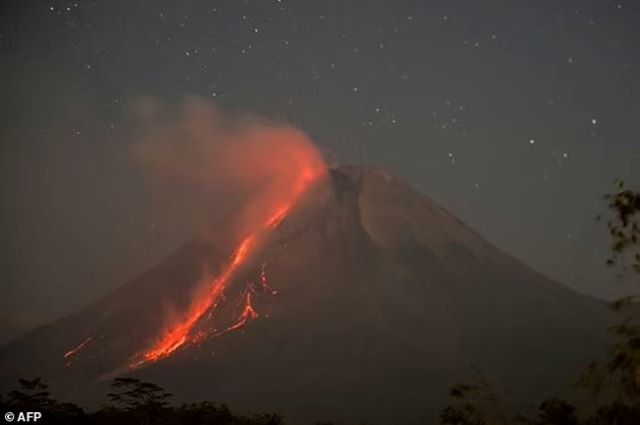Gunung Merapi Erupsi, Muntahkan Awan Panas Sejauh 3,5 Kilometer
Lava Streams from Indonesia´s Mount Merapi in New Eruption
Editor : Kemal A Praghotsa
Translator : Novita Cahyadi

GUNUNG MERAPI di Yogyakarta kembali mengalami erupsi sebanyak dua kali dengan mengeluarkan awan panas yang mengalir sampai 3,5 kilometer. Suara gemuruhnya dapat terdengar beberapa kilometer jauhnya, mengirimkan abu panas 600 meter ke udara.
Abu menyelimuti kota-kota terdekat, tetapi perintah evakuasi sudah lama diberlakukan di dekat Gunung Merapi. Tidak ada korban jiwa dilaporkan atas kejadian ini.
"Itu adalah aliran lahar terbesar Gunung Merapi sejak pihak berwenang menaikkan tingkat bahayanya November lalu," kata Kepala Balai Penyelidikan dan Pengembangan Teknologi Kebencanaan Geologi [BPPTKG], Hanik Humaida, pada Senin [16/08].
Ia mengatakan kubah lava tepat di bawah tepi barat daya Gunung Merapi dan kubah lava di kawah telah aktif sejak akhir Juli. Volume kubah tepi barat daya diperkirakan mencapai 1,8 juta meter kubik dan tinggi sekitar tiga meter sebelum sebagian runtuh pada Senin pagi.
Dengan demikian, BPPTKG masih menetapkan status Gunung Merapi pada level III atau Siaga sejak November lalu. Masyarakat dihimbau untuk tetap waspada terhadap bahaya lava dan tinggal lima kilometer jauhnya dari mulut kawah.
Gunung Merapi adalah yang paling aktif dari lebih dari 120 gunung berapi aktif di Indonesia dan telah berulang kali meletus dengan awan lava dan gas baru-baru ini, seperti dikutip PA Media yang dilansir MailOnline.
INDONESIA´S most active volcano has erupted with its biggest lava flow in months, sending a river of lava and searing gas clouds flowing 3.5 kilometres (more than two miles) down its slopes on the densely populated island of Java.
The rumbling sound could be heard several kilometres away as Mount Merapi erupted, sending hot ash 600 metres (nearly 2,000ft) into the sky.
Ash blanketed nearby towns, but long-established evacuation orders are in place near the volcano, and no casualties were reported.
It was Merapi’s biggest lava flow since authorities raised its danger level last November, said Hanik Humaida, the head of Yogyakarta’s Volcanology and Geological Hazard Mitigation Centre.
She said the lava dome just below Merapi’s southwest rim and the lava dome in the crater have both been active since the end of July.
The southwest rim dome volume was estimated at 1.8 million cubic metres (66.9 million cubic feet) and about three metres (9.8ft) tall before partially collapsing on Monday morning, sending pyroclastic flows travelling fast down the southwest flank at least twice.
Smaller pyroclastic flows of searing gas and lava travelled up to 1.5 kilometres (a mile) southwest at least twice more during the day.
The 2,968-metre (9,737ft) peak is near Yogyakarta, an ancient city of several hundred thousand people embedded in a large metro area on the island of Java.
The city is a centre of Javanese culture and a seat of royal dynasties going back centuries.
Merapi’s alert status has been at the second highest of four levels since it began erupting last November, and Indonesia’s Volcanology and Geological Hazard Mitigation Centre has not raised it despite the past week’s increased volcanic activity.
The four levels describe eruption activity as normal, minor, moderate or major.
People are advised to stay five kilometres (3.1 miles) from the crater’s mouth and to beware of the peril of lava, the agency said.
Ash from the eruption blanketed several villages and nearby towns, Ms Humaida said.
Cloudy weather obscured views of the peak.
Mount Merapi is the most active of more than 120 active volcanoes in Indonesia and has repeatedly erupted with lava and gas clouds recently.
Authorities in November had evacuated nearly 2,000 people living on the fertile slopes of the mountain in Magelang and Sleman districts and about 550 more people in January, but most have since returned.
Merapi’s last major eruption in 2010 killed 347 people and caused the evacuation of 20,000 villagers.
Indonesia, an archipelago of 270 million people, is prone to earthquakes and volcanic activity because it sits along the Pacific Ring of Fire, a horseshoe-shaped series of seismic fault lines around the ocean.















